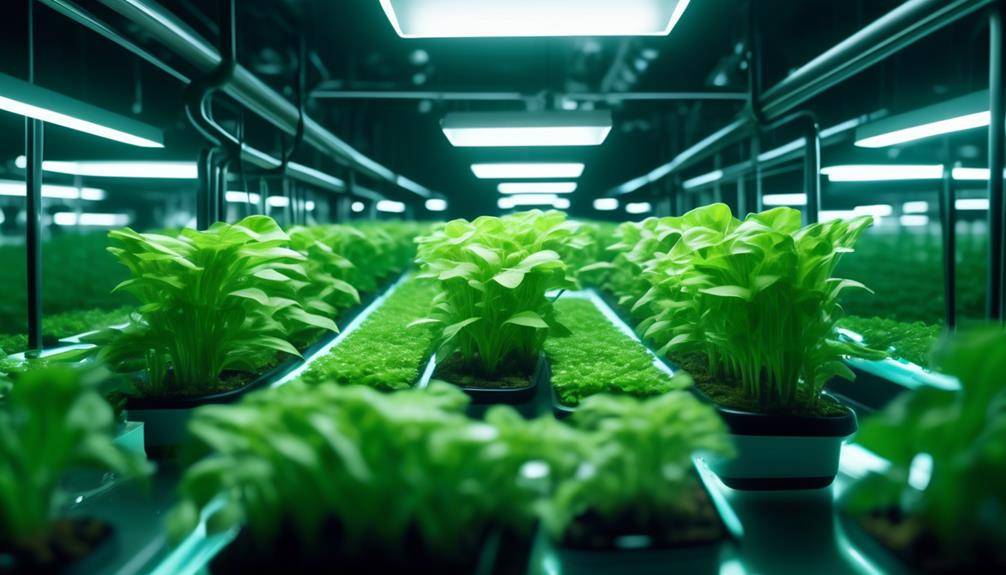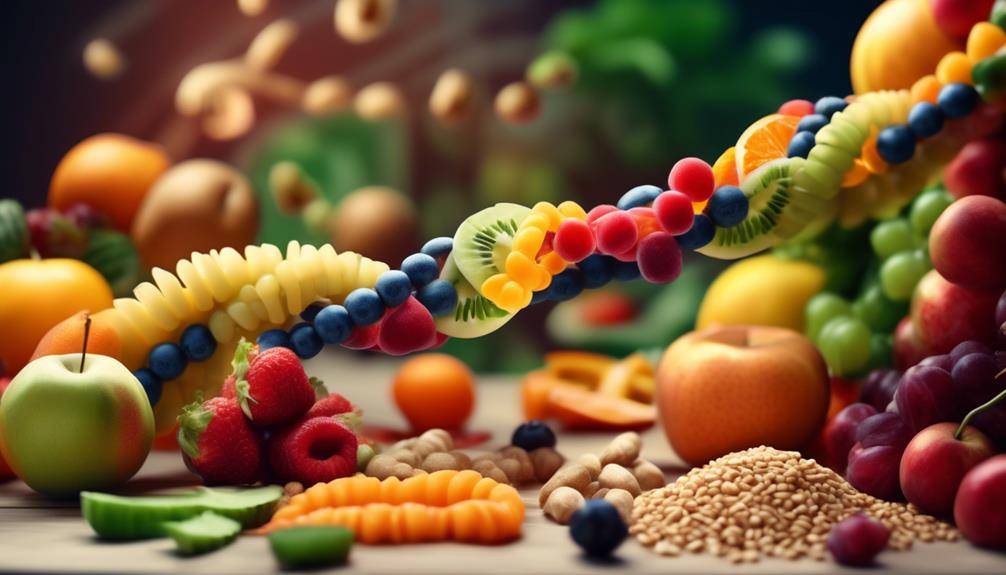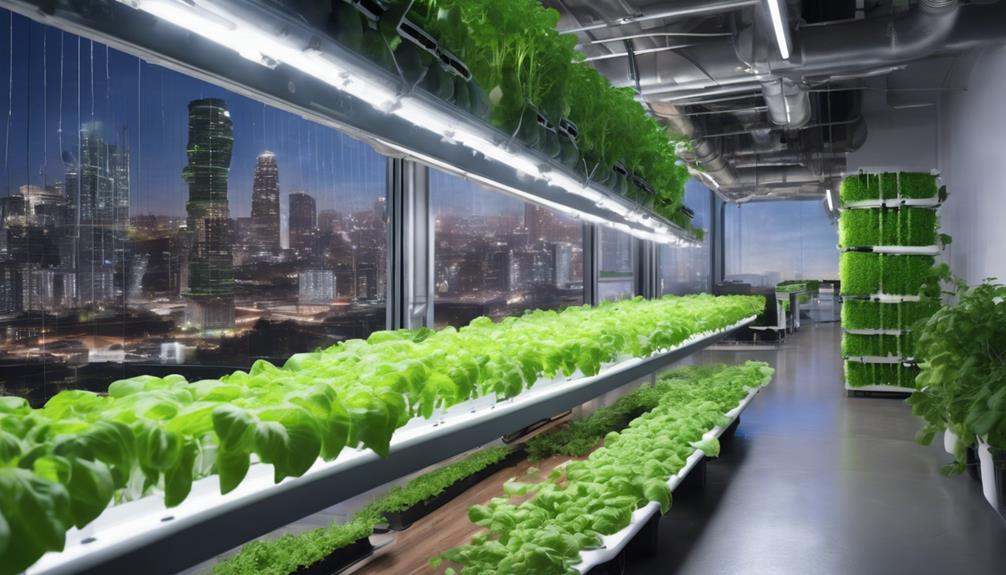Learn More About Hydroponics: The Future Of Farming

Hydroponics: The Future Of Farming; Imagine a world where you could grow crops without soil, in a controlled environment, and with minimal water usage. Sounds like something out of a science fiction novel, right? Well, get ready to have your mind blown, because hydroponics is here to revolutionize the way we farm. In this discussion, we will explore the incredible potential of hydroponics and how it could shape the future of agriculture. From its numerous advantages to the different types of systems available, we will uncover the secrets behind this innovative farming method. Get ready to discover a whole new way of growing crops, one that promises higher yields, reduced environmental impact, and a more sustainable future.
The Basics of Hydroponics
In hydroponics, plants are grown without soil, using a nutrient-rich water solution to provide the necessary elements for their growth. This method has several advantages over traditional soil-based farming. First and foremost, hydroponics allows for greater control over the growing environment. By carefully monitoring and adjusting factors such as light, temperature, and nutrient levels, growers can optimize plant growth and maximize yields. Additionally, the use of a soilless system eliminates the need for pesticides and herbicides, as well as the risk of soil-borne diseases. This not only reduces environmental pollution but also ensures the production of cleaner, healthier crops.
Another advantage of hydroponics is the ability to grow plants in areas with limited access to arable land. By utilizing vertical farming techniques, growers can stack multiple layers of plants, effectively increasing the cultivation area. This makes hydroponics a viable solution for urban farming, where space is often scarce. Moreover, hydroponics systems can be designed to be highly efficient in terms of water usage. Compared to traditional farming, which can be water-intensive, hydroponics requires significantly less water due to its closed-loop system. This is particularly beneficial in regions facing water scarcity or drought conditions.
However, hydroponics does come with some disadvantages. One major challenge is the initial high cost of setting up a hydroponic system. The required equipment, such as pumps, grow lights, and nutrient solutions, can be expensive, making it less accessible for small-scale farmers. Additionally, the reliance on a constant supply of electricity and water can increase operational costs. Furthermore, the complex nature of hydroponics requires a certain level of technical knowledge and expertise, which may pose a barrier for inexperienced growers.
Despite these disadvantages, the advantages of hydroponics make it a promising solution for sustainable and efficient farming. With further advancements in technology and increased accessibility, hydroponics has the potential to revolutionize the way we grow food.
Advantages of Hydroponic Farming
Hydroponic farming offers numerous advantages for growers, including increased control over plant growth and reduced environmental impact. Here are the key advantages of hydroponic farming:
- Optimized nutrient delivery: In hydroponics, plants are grown in a nutrient-rich solution, allowing for precise control over their nutrient intake. This ensures that plants receive the optimal balance of nutrients, leading to faster growth, higher yields, and improved crop quality compared to traditional soil-based farming.
- Water efficiency: Hydroponics uses up to 90% less water compared to conventional farming methods. This is because the nutrient solution used in hydroponics is recirculated, reducing water waste. Additionally, hydroponic systems can be designed to minimize water evaporation, making them ideal for regions facing water scarcity.
- Year-round cultivation: With hydroponics, growers have the ability to cultivate crops throughout the year, regardless of seasonal limitations. By controlling the growing environment, including temperature, humidity, and light, growers can create optimal conditions for plant growth, resulting in continuous and consistent production.
- Reduced environmental impact: Hydroponic farming significantly reduces the use of pesticides and herbicides, as the controlled environment minimizes the risk of pest infestations. Additionally, hydroponics eliminates the need for soil tilling, reducing soil erosion and nutrient runoff, which can pollute waterways. This sustainable farming method also eliminates the reliance on synthetic fertilizers, contributing to a healthier ecosystem.
It’s important to mention that hydroponic farming also has some disadvantages. Initial setup costs can be higher compared to traditional farming methods, and the complexity of the systems may require specialized knowledge and skills. Additionally, power outages or equipment malfunctions can disrupt the entire operation, posing a risk to crop health and production. Despite these challenges, the numerous advantages of hydroponic farming make it an attractive option for growers looking to increase productivity while minimizing environmental impact.
Essential Components for a Hydroponic System
To set up a successful hydroponic system, there are three essential components you need to consider. First, nutrient solutions provide the necessary elements for plant growth and development, replacing the need for soil. Second, growing mediums, such as perlite or coconut coir, support the plant’s root system and help retain moisture. Finally, water circulation is crucial to deliver nutrients and oxygen to the plants, ensuring their health and productivity. These components work together to create an efficient and sustainable hydroponic system.
Nutrient Solutions
For a successful hydroponic system, the nutrient solutions play a crucial role in providing the essential components necessary for plant growth. Nutrient absorption is a vital process for plants as they obtain the necessary elements from the surrounding solution. Nutrient deficiency can lead to stunted growth, yellowing leaves, and reduced crop yields. To ensure optimal nutrient absorption and prevent deficiencies, it is important to maintain a well-balanced nutrient solution. Here are the essential components of a nutrient solution:
- Macronutrients: These include nitrogen, phosphorus, and potassium, which are required in large quantities for plant growth and development.
- Micronutrients: These are trace elements like iron, zinc, and manganese, which are needed in smaller amounts but are equally important for plant health.
- pH Adjusters: Hydroponic systems require careful monitoring and adjustment of pH levels to ensure proper nutrient availability.
- Additives: Some nutrient solutions may require additional supplements like calcium or magnesium to address specific deficiencies or enhance plant growth.
Growing Mediums
Maintaining a well-balanced nutrient solution is just the first step in creating an optimal hydroponic system; the next essential component to consider is the choice of growing mediums. Growing media options play a crucial role in hydroponics as they provide support and anchorage for the plants’ roots, while also allowing for the efficient delivery of nutrients.
There are various growing media options available, including perlite, vermiculite, coconut coir, rockwool, and clay pellets. Each medium has its own unique characteristics that affect water retention, aeration, and nutrient availability. It is important to choose a growing medium that suits the specific needs of the plants being grown and the desired nutrient delivery system. By selecting the right growing media, you can ensure optimal plant growth and maximize the efficiency of your hydroponic system.
Water Circulation
Water circulation is a crucial component of a hydroponic system, ensuring the efficient delivery of nutrients and oxygen to the plants’ roots. To optimize water circulation and maintain water quality, the following techniques can be employed:
- Water Pumps: Utilize water pumps to create movement and circulation within the system. This helps in preventing stagnant water and ensures even distribution of nutrients.
- Aeration Systems: Incorporate aeration systems such as air stones or diffusers to increase oxygen levels in the water. Proper oxygenation is essential for healthy root development and nutrient absorption.
- Filtration Systems: Install filtration systems to remove impurities and maintain water quality. This helps in preventing clogging of irrigation lines and the accumulation of harmful substances.
- Water Level Control: Implement water level control mechanisms, such as float valves or sensors, to maintain the ideal water level and prevent overflows or shortages.
Different Types of Hydroponic Systems
In the realm of hydroponics, a diverse range of systems exists to suit the specific needs of different plants and growing environments. One such system is vertical farming, which involves growing plants in vertically stacked layers. This method maximizes space utilization, making it ideal for urban settings with limited land availability. Vertical farming systems typically use a combination of hydroponics and artificial lighting to provide optimal growing conditions for the plants.
Another type of hydroponic system that has gained popularity is aeroponic systems. In aeroponics, plants are suspended in air, and their roots are misted with a nutrient-rich solution. This method allows for maximum oxygen exposure to the roots, promoting faster and healthier growth. Aeroponics also conserves water as it uses a fraction of what traditional soil-based farming requires.
NFT (Nutrient Film Technique) is another commonly used hydroponic system. In NFT, a thin film of nutrient-rich water flows continuously over the roots of the plants, providing them with a constant supply of nutrients. This system is particularly effective for growing leafy greens and herbs.
Drip irrigation systems are widely used in hydroponics as well. This method involves dripping a nutrient solution directly onto the roots of the plants. The excess solution is collected and recirculated, minimizing water waste.
Lastly, there are ebb and flow systems, also known as flood and drain systems. In this method, the plants are periodically flooded with a nutrient solution and then the excess solution is drained away. This cycle provides the plants with the necessary nutrients and oxygen while preventing waterlogging.
Each of these hydroponic systems offers unique advantages and can be tailored to suit the requirements of different plants and growing environments. By harnessing the power of hydroponics and using these innovative systems, the future of farming looks promising.
Choosing the Right Plants for Hydroponics
When selecting plants for hydroponics, it is essential to consider their specific requirements and growth characteristics. Choosing the right plant varieties is crucial for achieving optimal results in hydroponic systems. To ensure successful growth and high yields, here are some best practices for seed selection in hydroponics:
- Disease and pest resistance: Look for plant varieties that are known for their resistance to common diseases and pests in hydroponic environments. This will help minimize the risk of crop loss and the need for chemical interventions.
- Compact growth habit: Opt for plants that have a compact growth habit, as this allows for more efficient use of space in a hydroponic system. Compact plants also tend to have stronger stems, which can support the weight of the crop without the need for additional structural support.
- High yields: Choose plant varieties that are known for their high yields in hydroponic systems. These varieties have been specifically bred and selected for their ability to thrive in soilless environments and produce abundant harvests.
- Fast growth rate: Consider plant varieties that have a fast growth rate, as this allows for quicker turnover and more frequent harvests. Fast-growing plants also tend to be more responsive to nutrient and environmental conditions, making it easier to maintain optimal growth conditions in a hydroponic system.
Nutrient Management in Hydroponics
When it comes to nutrient management in hydroponics, there are several key points to consider. First, nutrient solutions are essential for the growth and development of plants in a hydroponic system. These solutions provide the necessary nutrients for the plants to thrive, including nitrogen, phosphorus, and potassium. Second, maintaining the correct pH balance is crucial in hydroponics, as it affects nutrient availability and uptake by the plants. Finally, monitoring nutrient levels is a critical aspect of nutrient management, ensuring that plants receive the right amount of nutrients at the right time to promote healthy growth and maximize yields.
Nutrient Solutions for Growth
To optimize plant growth and ensure proper nutrient uptake, hydroponic systems require carefully formulated nutrient solutions. These solutions provide essential nutrients to plants, allowing them to thrive without soil. When it comes to nutrient solution formulation, there are several key considerations to keep in mind:
- Macronutrients: These include nitrogen (N), phosphorus (P), and potassium (K), which are essential for plant growth and development.
- Micronutrients: These are trace elements that plants require in small quantities, such as iron (Fe), manganese (Mn), and zinc (Zn).
- pH Balance: Maintaining the correct pH level is crucial for nutrient availability and uptake by plants.
- Hydroponic Crop Selection: Different crops have varying nutrient requirements, so it’s important to choose appropriate nutrient solutions tailored to specific crops.
Ph Balance and Nutrients
Maintaining the proper pH balance in hydroponic nutrient solutions is crucial for optimizing nutrient availability and ensuring healthy plant growth. In hydroponics, where plants grow without soil, nutrient deficiencies can occur if the pH levels are not properly adjusted. To ensure the optimal pH balance, it is important to regularly test the nutrient solution. There are several methods available for pH testing, including pH test strips, pH meters, and pH indicator solutions.
Test strips are convenient and easy to use, providing a quick pH reading. pH meters offer a more accurate measurement, but they require calibration and maintenance. pH indicator solutions involve adding a few drops of the solution to the nutrient solution and observing the color change, which can indicate the pH level. By regularly monitoring and adjusting the pH levels, nutrient deficiencies can be prevented, promoting healthy plant growth in hydroponics systems.
Monitoring Nutrient Levels
To ensure optimal nutrient uptake and plant health, it is essential to closely monitor the nutrient levels in hydroponic systems. Continuous monitoring and control of nutrient levels are crucial for maintaining the right balance and preventing deficiencies or toxicities. Here are four key reasons why monitoring nutrient levels is important in hydroponics:
- Optimal nutrient uptake: Regular monitoring allows you to adjust nutrient concentrations to meet the specific needs of your plants, ensuring they receive the right amount of essential elements for growth and development.
- Prevention of nutrient imbalances: Monitoring helps identify and correct imbalances before they become detrimental to plant health. This includes adjusting nutrient ratios and maintaining appropriate pH levels.
- Early detection of nutrient deficiencies or toxicities: By monitoring nutrient levels, you can quickly identify and address any deficiencies or toxicities, preventing potential damage to your plants and optimizing their overall health.
- Fine-tuning nutrient management: Continuous monitoring provides valuable data that allows you to fine-tune your nutrient management strategies, optimizing resource allocation and improving overall system efficiency.
Lighting Requirements for Hydroponic Plants
Lighting plays a crucial role in meeting the specific needs of hydroponic plants, ensuring optimal growth and development. Hydroponic plants rely on artificial lighting as a substitute for natural light sources. While natural light is the ideal source, it may not always be available or sufficient for indoor hydroponic systems. Therefore, artificial lighting is used to provide the necessary light spectrum and intensity for the plants.
When it comes to lighting requirements for hydroponic plants, two factors should be considered: light spectrum and light intensity. The light spectrum refers to the specific wavelengths of light that plants need for photosynthesis. Different stages of plant growth require different light spectrums. For instance, blue light is crucial for vegetative growth, while red light is essential for flowering and fruiting. LED lights have become popular in hydroponics due to their ability to provide specific light spectrums that promote plant growth at different stages.
Light intensity, measured in foot-candles or lux, refers to the amount of light reaching the plant’s surface. Different plants have varying light intensity requirements. Leafy greens, for example, require lower light intensities compared to fruiting crops like tomatoes or peppers. The distance between the light source and the plant also affects light intensity. As the distance increases, light intensity decreases. Therefore, it’s important to position the lights at the appropriate height to ensure the plants receive the required light intensity.
Maintaining Optimal Temperature and Humidity
To maintain optimal temperature and humidity in a hydroponic system, you can employ various temperature control techniques, such as using thermostats and fans to regulate the temperature. Additionally, managing humidity is crucial for the health of your plants, and you can achieve this by using dehumidifiers or misting systems. By ensuring these optimal growing conditions, you can provide a favorable environment for your hydroponic plants to thrive and maximize their growth potential.
Temperature Control Techniques
Maintaining optimal temperature and humidity in hydroponic systems is vital for the successful growth and development of plants. To achieve this, various temperature control techniques and energy-efficient systems are employed. Here are four important techniques:
- Cooling Systems: Implementing cooling systems, such as fans or air conditioners, helps regulate the temperature within the hydroponic environment. These systems remove excess heat and maintain a consistent temperature range.
- Heating Systems: In colder climates or during winter months, heating systems are used to provide warmth to the plants. This ensures that the temperature remains within the optimal range for growth.
- Thermal Insulation: Insulating the hydroponic system helps to minimize heat loss and maintain stable temperatures. It prevents external temperature fluctuations from affecting plant growth.
- Humidity Control: Controlling humidity levels is crucial for preventing mold and disease. Humidity can be regulated through the use of dehumidifiers or humidifiers, maintaining the optimal range for plant health.
Humidity Management Tips
To ensure optimal temperature and humidity levels in hydroponic systems, efficient management techniques are critical for ensuring healthy plant growth and preventing mold and disease. Humidity control is essential in hydroponics as excessive moisture can lead to the growth of mold and the spread of diseases among plants. To manage humidity effectively, it is important to monitor and maintain the relative humidity levels within the recommended range of 50% to 70%. This can be achieved by using dehumidifiers or exhaust fans to remove excess moisture from the air.
Additionally, proper ventilation and air circulation can help in preventing the buildup of humidity in the grow area. Regularly checking and adjusting the humidity levels, along with maintaining a clean and sanitized environment, will contribute to successful hydroponic cultivation.
Optimal Growing Conditions
In order to ensure optimal growing conditions in hydroponic systems, it is essential to maintain the ideal temperature and humidity levels. Here are four key factors to consider when aiming to create a controlled environment for vertical farming:
- Temperature: Maintain a consistent temperature range between 68°F and 78°F (20°C and 26°C) to promote healthy plant growth. Fluctuations outside this range can lead to stress and hinder productivity.
- Humidity: Aim for a relative humidity level between 50% and 70% to prevent excessive moisture or dryness in the air. This range helps promote transpiration, nutrient uptake, and disease prevention.
- Ventilation: Ensure proper airflow by using fans or vents to prevent stagnant air. This promotes CO2 distribution, reduces the risk of mold or fungal growth, and helps control temperature and humidity.
- Monitoring and automation: Implement sensors and an automated control system to continuously monitor and adjust temperature and humidity levels. This ensures consistency and precision in maintaining optimal growing conditions.
Common Pests and Diseases in Hydroponics
Common pests and diseases pose significant challenges in hydroponic farming, requiring vigilant monitoring and proactive management strategies. As a hydroponic farmer, it is crucial to be aware of the most common pests that can affect your crops and implement effective disease control measures.
One of the most prevalent pests in hydroponic systems is the aphid. These small insects feed on the sap of plants, causing damage to the leaves and stems. To control aphids, you can introduce natural predators such as ladybugs or lacewings into your system. Additionally, regularly inspecting your plants and removing any infested ones can help prevent the spread of aphids.
Another common pest is the whitefly. These tiny insects typically reside on the undersides of leaves, sucking out plant sap and leaving behind a sticky residue known as honeydew. Yellow sticky traps can be used to monitor and control whitefly populations. Additionally, introducing biological control agents like parasitic wasps can effectively manage whitefly infestations.
Disease control is also crucial in hydroponic farming. One common disease is powdery mildew, a fungal infection that appears as a white powdery coating on the leaves. To prevent powdery mildew, maintain proper air circulation and humidity levels in your hydroponic system. If an infection does occur, removing infected plant parts and applying fungicides specifically labeled for hydroponic use can help control its spread.
Harvesting and Storing Hydroponic Produce
Harvesting and storing hydroponic produce requires careful attention to ensure the quality and freshness of your crops. When it comes to harvesting techniques, there are a few key points to keep in mind:
- Timing: Harvest your hydroponic crops when they are at their peak ripeness. This will vary depending on the specific plant and its growth cycle. Monitor the plants closely and look for visual cues, such as color and size, to determine the optimal time for harvest.
- Tools: Use appropriate tools for harvesting to avoid damaging the plants. Sharp, clean scissors or shears are often recommended for cutting the stems or leaves. Be gentle when handling the produce to prevent bruising or crushing.
- Cleaning: After harvesting, it is important to clean the produce thoroughly. Use clean water to rinse off any dirt or debris. This step is crucial to maintain the quality and prevent any potential contamination.
- Post-harvest storage: Proper storage is essential to prolong the shelf life of your hydroponic produce. Consider the following factors:
- Temperature: Store your crops at the appropriate temperature to slow down spoilage. Some crops require refrigeration, while others may be stored at room temperature.
- Humidity: Maintain the ideal humidity level for your specific crops. Some produce benefits from higher humidity, while others require a drier environment.
- Packaging: Package your harvested produce in breathable containers or bags to allow for proper air circulation. This helps to prevent moisture build-up and prolongs freshness.
The Future of Hydroponics in Agriculture
To explore the potential of hydroponics in revolutionizing agriculture, it is crucial to delve into its future prospects and advancements. Hydroponics has gained significant attention as a sustainable farming practice, and its future looks promising with further advancements in technology and innovative practices.
One of the key areas of future advancements in hydroponics lies in automation. As technology continues to advance, automated systems are being developed to monitor and control various aspects of hydroponic farming, such as nutrient levels, pH balance, and temperature. These advancements will not only increase efficiency but also minimize human error, leading to higher yields and reduced resource wastage.
Another aspect of future advancements in hydroponics is the development of more sustainable practices. Hydroponics has the potential to significantly reduce water usage compared to traditional farming methods. However, there is still room for improvement in terms of energy consumption and waste management. Researchers are actively working on developing more energy-efficient lighting systems and finding innovative ways to recycle and reuse nutrient solutions.
In addition to technological advancements, the future of hydroponics in agriculture also depends on the adoption of sustainable practices on a larger scale. As the demand for fresh produce continues to rise, hydroponics can play a vital role in meeting this demand while minimizing the environmental impact of farming. Governments, farmers, and consumers need to recognize the importance of sustainable farming practices and support the growth of hydroponics as a viable alternative.
Hydroponics: The Future Of Farming; Frequently Asked Questions
Can Hydroponic Farming Be Used in All Types of Climates?
Yes, hydroponic farming can be used in all types of climates. It is particularly useful in extreme climates where traditional farming is challenging. Additionally, hydroponics is a great solution for urban areas with limited space for agriculture.
How Much Water Does Hydroponic Farming Save Compared to Traditional Farming Methods?
Hydroponic farming saves a significant amount of water compared to traditional farming methods. By providing water directly to the plant’s roots, hydroponics eliminates water loss through evaporation and runoff, resulting in water conservation and a reduced environmental impact.
Are Hydroponically Grown Plants as Nutritious as Conventionally Grown Plants?
Hydroponically grown plants may offer similar nutritional benefits as conventionally grown plants. However, there are limitations to hydroponic farming, such as potential nutrient deficiencies and the need for careful monitoring and management to ensure optimal plant health.
What Are the Main Challenges in Scaling up Hydroponic Farming to Meet Global Food Demand?
Scaling up hydroponic farming to meet global food demand presents several challenges. These include high initial investment costs, efficient management of nutrient solutions, and the need for advanced technology to optimize growth conditions for different plant species.
How Does Hydroponic Farming Contribute to Sustainable Agriculture and Food Security?
Hydroponic farming contributes to sustainable agriculture and food security through its ability to optimize soil fertility and resource efficiency. By providing precise nutrient solutions and conserving water and space, hydroponics offers a promising solution for meeting global food demand.
Conclusion
In conclusion, hydroponics offers numerous advantages for the future of farming. Its ability to grow plants without soil, the efficient use of water and nutrients, and the potential for year-round production make it a promising solution for sustainable agriculture. By understanding the essential components, choosing the right plants, and maintaining optimal conditions, hydroponic farmers can overcome common challenges and maximize their yields. As technology advances and more research is conducted, the future of hydroponics in agriculture looks bright.








